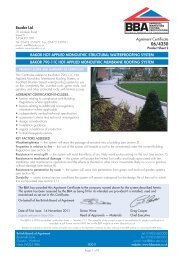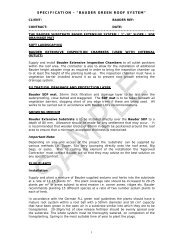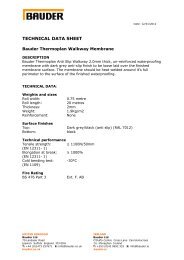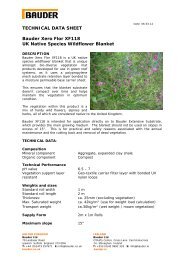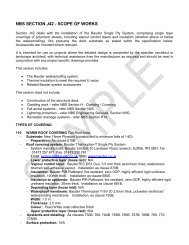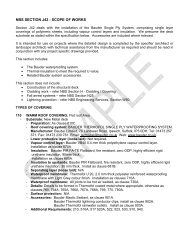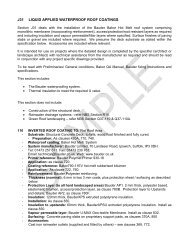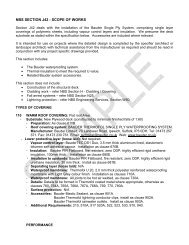The GRO Green Roof Code - SIG Design and Technology
The GRO Green Roof Code - SIG Design and Technology
The GRO Green Roof Code - SIG Design and Technology
Create successful ePaper yourself
Turn your PDF publications into a flip-book with our unique Google optimized e-Paper software.
5.2 Maintenance Actions by <strong>Roof</strong> Types<br />
5.2.1 Extensive <strong>Roof</strong> Maintenance - < 100mm low nutrition substrate<br />
• Irrigation: Post-establishment, irrigation should not be required for most extensive green roofs, although the<br />
water storage capacity of the system <strong>and</strong> the plants’ water dem<strong>and</strong>s should be appropriately assessed.<br />
• Fertilization: Extensive green roofs typically have low nutrient requirements <strong>and</strong> are therefore often fertilized<br />
on an annual basis, each spring, using a slow-release fertilizer.<br />
• Plant management: Removal of undesirable plant species <strong>and</strong> fallen leaves should take place twice<br />
each year<br />
• General: Drainage outlets (including inspection chambers) <strong>and</strong> shingle/gravel perimeters to be cleared of<br />
vegetation, twice yearly<br />
5.2.2 Biodiverse – very low to low nutrition substrate<br />
• Irrigation: Typically not required<br />
• Fertilization: Generally not required, particularly where indigenous species are being encouraged to replicate<br />
native habitats. Whilst a low vegetative density is common, zero vegetation is generally undesirable<br />
• Plant Management: A maintenance programme should be drawn up to follow the biodiversity hypothesis,<br />
ensuring that no materials are removed from the roof that may adversely affect the biodiversity potential<br />
of the roof<br />
• General: Drainage outlets (with inspection chambers) <strong>and</strong> gravel/shingle perimeters should be inspected<br />
twice yearly <strong>and</strong> cleared of any living or dead vegetation<br />
5.2.3 Semi Intensive – 100mm to 200mm low to medium nutrition substrate<br />
• Irrigation: Periodic irrigation is expected, depending upon the plant specification <strong>and</strong> the climatic <strong>and</strong><br />
microclimatic conditions prevailing at roof level.<br />
• Fertilization: With a wider range of planting, using a more fertile growing medium, more regular fertilization<br />
is required.<br />
• Plant management: Removal of undesirable vegetation on the greened area twice yearly.<br />
• General: Drainage outlets (including inspection chambers) <strong>and</strong> shingle/gravel perimeters to be cleared of<br />
vegetation, twice yearly<br />
5.2.4 Intensive – 200mm + medium nutrition substrates <strong>and</strong> top soils<br />
• Irrigation: Regular irrigation is often required, subject to the plant specification <strong>and</strong> the climatic <strong>and</strong><br />
microclimatic conditions prevailing at roof level.<br />
• Fertilization: With a wider range of planting, using a more fertile growing medium, more regular fertilization<br />
is required.<br />
• Plant management: <strong>The</strong> intensive maintenance of lawns, hedges, borders etc is required on a regular basis,<br />
so as to maintain the roof aesthetics. Undesirable vegetation should be removed from the green areas at<br />
least twice yearly. Failed plants in excess of 5% of the plants installed should be replaced.<br />
• General: Drainage outlets (including inspection chambers) <strong>and</strong> shingle/gravel perimeters to be cleared of<br />
vegetation, twice yearly. Where excessive substrate settlement has occurred, this should be replenished.




